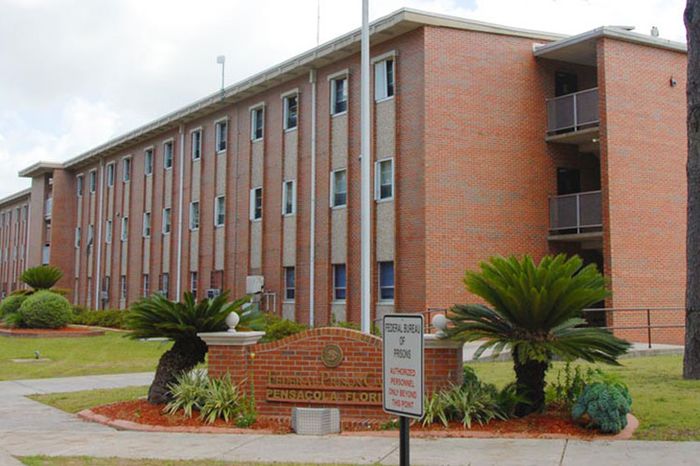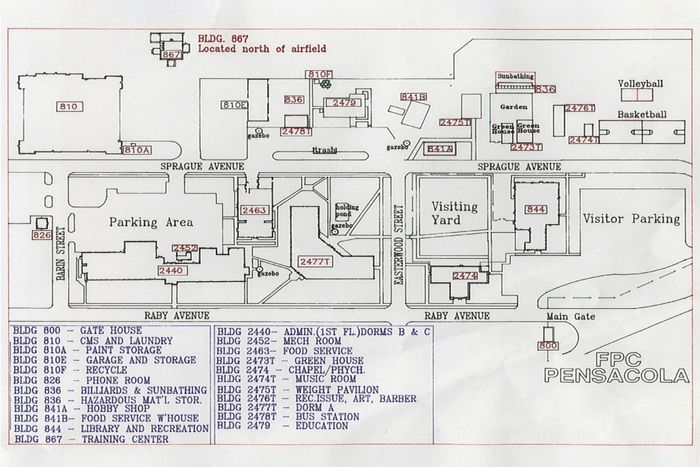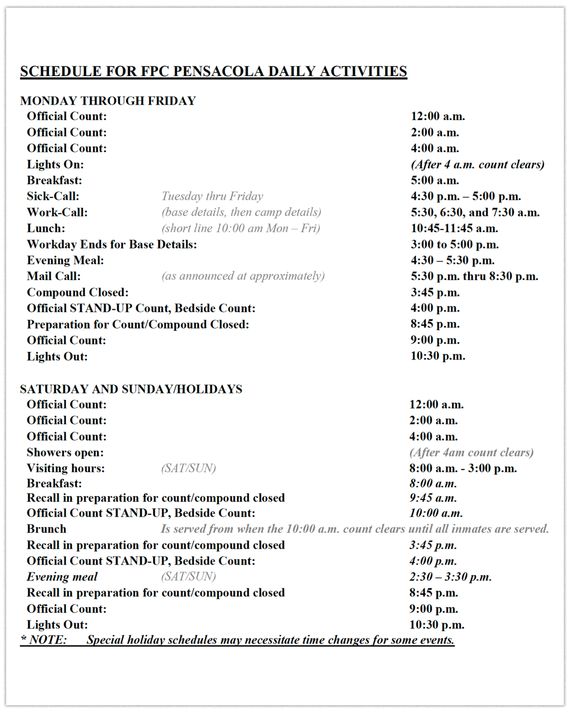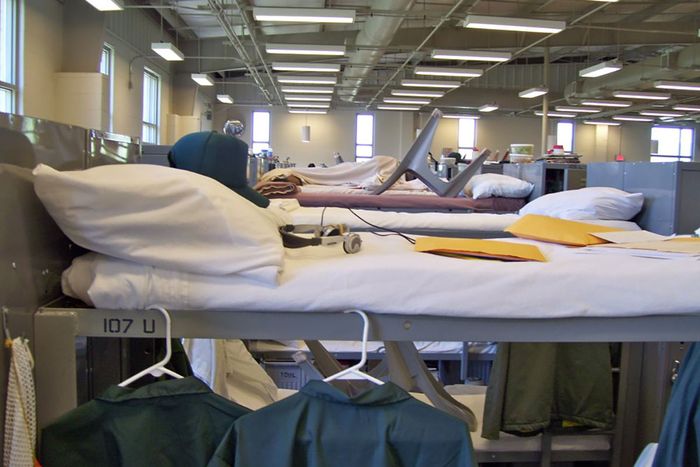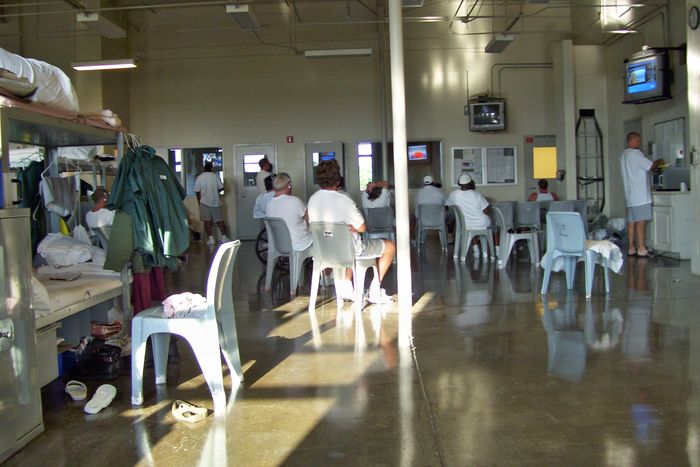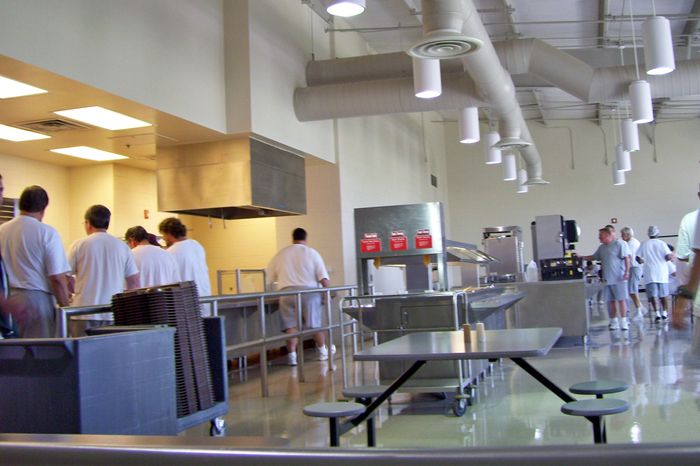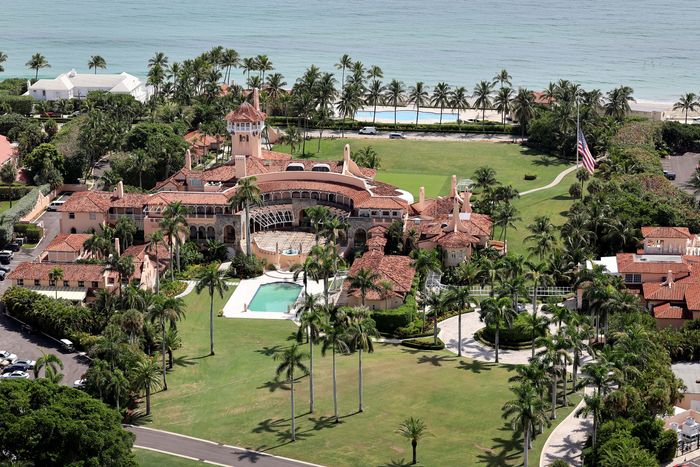
What Happens, Exactly, If Trump Is Sentenced to Prison?
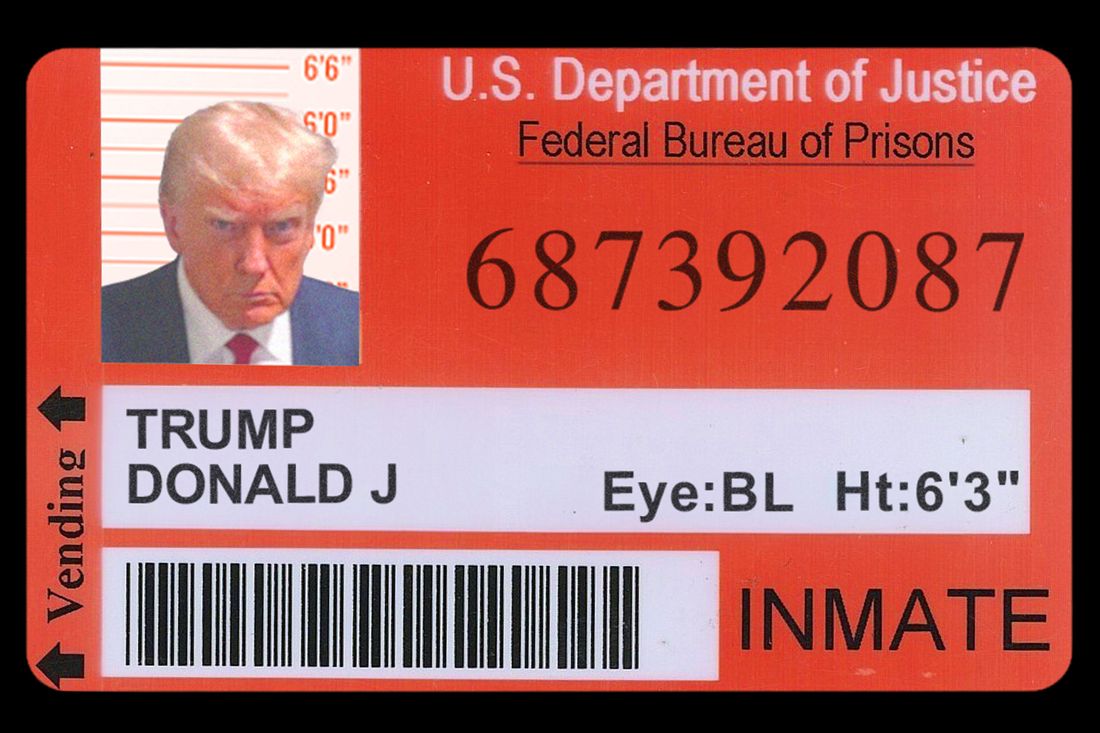
Photo-Illustration: Intelligencer
In the moments after the verdict, Donald Trump would not be hauled off to prison right away. White-collar defendants are typically allowed to remain out on bail pending sentencing, which means, in the case of our former and maybe future commander-in-chief, that he could continue to campaign for president in the meantime. But let’s game it out: If Trump is found guilty, how long till he has to put on an orange (or, as we’ll learn, olive-green) jumpsuit?
The odds of such an outcome jumped this week, after a panel of appellate judges in Washington, D.C., rejected Trump’s argument that he is immune from prosecution in Special Counsel Jack Smith’s case covering Trump’s attempts to overturn the 2020 election. “For the purpose of this criminal case,” the judges wrote, “former President Trump has become citizen Trump, with all of the defenses of any other criminal defendant.” Trump might seek a rehearing before the whole court or an appeal to the Supreme Court, but make no mistake: When (and it should be when, not if) Smith’s trial gets back on track, Trump is in serious trouble.
Ninety-nine percent of the January 6 cases that have gone to trial have ended with a conviction. Also, Trump faces a particularly unfriendly jury pool in D.C., where polls suggest as many as two-thirds of residents believe he is guilty. Trump’s advisers are treating the case like the threat that it is. They’ve told him bluntly that he needs to win his reelection bid in order to avoid prison time. (Jason Miller, a senior adviser to Trump’s campaign, declined to make Trump available for an interview, telling me that the premise of the story was “designed to try to undermine President Trump.”)
U.S. District Judge Tanya Chutkan, who is presiding over the D.C. case, would set a sentencing date — say, two to three months from the date of the conviction. If the trial takes place by the end of the summer, sentencing could happen just weeks before the election.
According to federal sentencing guidelines, Trump’s potential exposure is very high, at least on paper. Mark Allenbaugh, who once worked as a lawyer for the U.S. Sentencing Commission, sketched out an aggressive calculation for me that would result in a recommended sentence north of 20 years based on the violence and physical injuries that resulted from the siege of the Capitol, Trump’s status as both a public official and the leader of the effort, and a provision of the guidelines that permits an increase in the recommended sentence when “the offense was calculated to influence or affect the conduct of government by intimidation or coercion.”
Federal rules require judges to treat defendants equally “to avoid unwarranted sentence disparities among defendants with similar records who have been found guilty of similar conduct.” Here, we should look at what happened to the hundreds of people who have been sentenced in connection with the siege of the Capitol. Most of them — 467 out of 749 people, as of the start of the year — have been sentenced to a period of incarceration. Some of the most serious and defiant offenders, particularly those who engaged in violence or were carrying weapons, have received lengthy, yearslong terms of imprisonment. Others have received fairly modest sentences, measurable in single-digit months — perhaps because they pleaded guilty or their misconduct on the day was limited. Still others, like the “QAnon Shaman,” Jacob Chansley, were sentenced to several years in prison despite the fact that they did not engage in violence and ultimately pleaded guilty.
Put it all together, and it is far from clear why a nonviolent foot soldier in a campaign that Trump is accused of setting in motion should go to prison but Trump, if convicted, should not.
Judge Chutkan may also have been the worst possible draw for Trump among all of the judges in Washington. She has sentenced every single convicted January 6 defendant in her courtroom to a period of incarceration — at times ordering them to serve even more time than the proposal from prosecutors. At a hearing in late 2022, she gave a 50-year-old Ohio woman named Christine Priola 15 months after she pleaded guilty to obstructing Congress’s electoral certification. “The people who mobbed that Capitol were there in fealty, in loyalty, to one man — not to the Constitution,” Chutkan said. “It’s a blind loyalty to one person who, by the way, remains free to this day.”
The exterior of Federal Prison Camp Pensacola in Escambia County, Florida.
Photo: Federal Bureau of Prisons
The federal prison camp in Pensacola, Florida — an all-male minimum-security facility that currently holds about 500 convicts — is an eight-and-a-half-hour drive from Mar-a-Lago, not far from the border with Alabama. The complex contains 20 buildings, a track for jogging or walking, and designated recreational areas for inmates to play a variety of sports, including basketball, volleyball, soccer, and tennis. The prison has housed a variety of white-collar offenders, including former New York congressman Chris Collins (who was serving time for insider trading before being pardoned by Trump), and it is currently home to former reality-television star Todd Chrisley, who was sent there after being convicted of financial crimes.
FPC Pensacola, as it is known, is a leading contender for the prison that would house Trump. The process of selecting a facility for a convicted felon usually begins in the Designation and Sentence Computations Center of the Bureau of Prisons in Grand Prairie, Texas, where a specialist reviews the incoming prisoner’s file in order to generate a score that correlates to different levels of security — ranging from minimum- to high-security facilities. The relevant inputs include the nature of the offenses in generic terms (in Trump’s case, fraud and obstruction), the defendant’s criminal record, as well as his age, education level, and history of violent behavior or drug and alcohol abuse. The BOP is supposed to place each inmate in a facility that is reasonably close to where he will be released; in Trump’s case, that would presumably be Mar-a-Lago, which Trump designated as his legal residence in 2019.
Trump would likely “score out” at a minimum-security facility under the guidelines as written, but BOP officials retain wide latitude to change these designations. “They can find excuses to raise or lower his security designation if they want to,” said Hugh Hurwitz, a retired longtime career official at the BOP who served as the acting head of the agency for about 15 months during the Trump administration.
The idea of Trump serving time in a place like FPC Pensacola, with its open-air amenities and mild climate, might be disappointing to people who would prefer to see him in the sort of remote, high-security facility that houses terrorists, but it would be replete with indignities for the former president. Minimum-security prisons are still prisons. “You’re still not free to go wherever you want. You still have people telling you where to go, when to go, what have you,” Hurwitz told me. “You don’t have your freedom.”
The building directory of FPC Pensacola. The facility includes a sunbathing area and four gazebos.
Photo: Federal Bureau of Prisons
What would the typical day look like for Trump? Inmates at FPC Pensacola are assigned to sleep with other inmates, either in a hostel-like room with bunk beds or in a cubicle. The day starts with breakfast at 5 a.m. The uniform is an olive shirt that must be tucked in at all times, olive pants, white socks, and black shoes, unless the inmate’s work assignment requires different clothing. (Cafeteria workers wear white while on duty.)
“Everybody that’s in federal prison is expected to have a job if they’re physically and mentally able to do so,” Hurwitz explained. “Maybe they’re working maintenance on the grounds — you know, cutting grass — maybe they’re working in the kitchen, doing dishes or serving food; maybe if they have some skill in plumbing, they can help out in there.” Inmates get paid between 12 and 40 cents per hour.
In addition to work, Trump could participate in vocational, occupational, and educational programs that are available to inmates to ease their reentry into society after release and can earn them time off their sentence. “Once he arrives, he’ll do a needs assessment with the staff,” Hurwitz said. “They’ll figure out what his needs are, they’ll make recommendations to what programs he should take in order to meet those needs, and then it’ll be up to him to take the programs. But if he does take the programs, then that will likely earn him reduced time on his sentence.”
Trump’s ability to communicate with the outside world would be extremely limited. Cell phones are not allowed in federal prisons, though they are often smuggled in to minimum-security facilities. “He won’t have legal access to the internet,” Hurwitz noted, and though he would have limited access to email, “it is a very old-style email without graphics and things like that.” “He will not be able to tweet,” he continued. “He will not be able to even get on the internet or Facebook — none of that stuff.”
It’s an open question how Trump would spend his days. After all, Trump — to be perfectly blunt — does not excel at spelling, reading, or writing. It seems unlikely he would be able to pass much time checking out books from the library or corresponding with family and friends.
The daily schedule for FPC Pensacola inmates.
Photo: Federal Bureau of Prisons
On the plus side, however, a favorite Trump pastime — watching television, cable news in particular — could be readily accessible. There are televisions throughout the facility, and inmates use headphones with handheld electronic devices that allow them to tune in to different frequencies in order to switch between sets.
Television figures prominently in the life of an inmate in a federal prison camp, as Elton Thomas, who spent about nine years in a camp in California, told me. He was granted early release at the tail end of the Obama administration after a lawyer volunteered to prepare a commutation petition for him.
“For the most part,” when you are done with work, he recalled, “the rest of your day is watching television. You watch a lot of TV.” In Thomas’s particular facility, there was a television that was informally designated for news, and inmates could watch both local news and the major cable-news channels — including CNN, MSNBC, and Fox. Hurwitz told me that the availability of these channels in any given facility would ultimately depend on “what cable package they have.”
Federal prison facilities tend to be spartan, and opportunities for Trump to improve his material situation would be limited, though informal economies could help. In recent years, the commissary at FPC Pensacola has not carried Diet Coke, but another Trump favorite — ketchup — can be purchased for $2.55. A wide variety of other items are available — including candy, stamps, over-the-counter medicines, and packaged food — but inmates are limited to spending just $360 a month. One way around this limit is for you to have someone on the outside deposit money into the account of another inmate who is not spending their full allotment and then have that inmate purchase items for you in exchange for a cut.
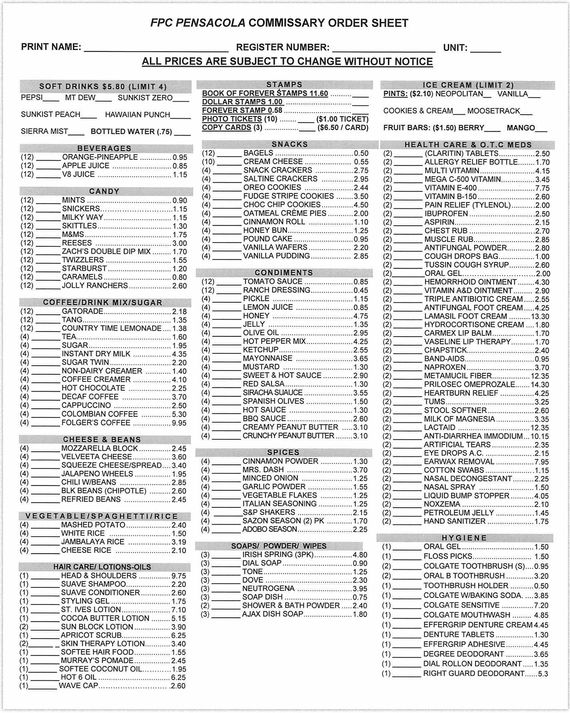

The commissary order sheet for FPC Pensacola. Federal Bureau of Prisons.
The commissary order sheet for FPC Pensacola. Federal Bureau of Prisons.
Keeping Trump safe in a facility like this would not be a straightforward process. Although federal prison camps are generally designed for nonviolent offenders, the government in Trump’s case would likely need to “do some very careful checking into who the other inmates are in that facility” in order to minimize the physical risk to Trump, Hurwitz told me.
A spokesperson for the Secret Service told me that the agency has “no existing policies or protocols” for the protection of a president in prison. Still, he maintained that the Secret Service “has developed protective models for some of the most austere climates around the globe” — perhaps most memorably in recent years when agents protected Joe Biden during a visit to Ukraine in the midst of the country’s war with Russia — and that agents would handle any situation that might arise.
“I will tell you, if you can think of a way to kill the president, we’ve already thought of it and planned mitigations,” Jeff James, a retired agent who worked for the Secret Service for more than 20 years, told me. But the possibility of protecting someone in federal custody “is something that, at least in my time, the Secret Service absolutely never talked about.”
I asked James to consider how he would approach the situation if he were tasked with devising a protection plan for Trump if he had to serve time. A minimum-security facility, he said, “would be our ideal scenario,” at least compared to other prisons, but the agency would still want to separate Trump from the general population. That could mean ensuring that Trump has his own area — or even building — to sleep in and that he has an on-site protection detail. “Our goal,” he said, “is that someone always has eyes on the people we protect with the exception of at night, when they’re sleeping.” (At night, protectees have access to panic buttons that they can use to alert the Secret Service if, say, they have a heart attack or choke on something.)
Dormitory-style housing at a minimum-security prison in Kentucky, similar to what is provided for inmates at FPC Pensacola.
Photo: Courtesy of The MPM Group, Inc.
Inmates watch television at a minimum-security federal prison.
Photo: Courtesy of The MPM Group, Inc.
“The folks in prison are a cross-section of society, so you’re going to have people that even in prison are going to love him and people who are going to hate him,” James said. “Just because they’re confined doesn’t mean we could cut him loose, because maybe somebody doesn’t want to kill him — maybe they just want to punch him in the face.”
Still, Trump has also proved undeniably adept over the years at cultivating adoration in improbable settings, from improbable sources, including tens of millions of Americans who have never encountered the sort of privilege that has ensconced Trump throughout his entire life. Maybe he’d be popular!
Even so, routines as mundane as food service in the cafeteria might need to be revamped. Presidents do not have food tasters, but in large dining settings, the Secret Service might “have the chef make up a several dozen plates for the dinner and then someone would just go pick one of those at random,” James told me, “so if that chef wanted to kill the president, they would have to kill everybody.” In a prison setting, “maybe that protocol changes so they prepare 25 trays and somebody just goes and grabs one” for Trump.
Inmates are served three meals each day in the Food Service building.
Photo: Courtesy of The MPM Group, Inc.
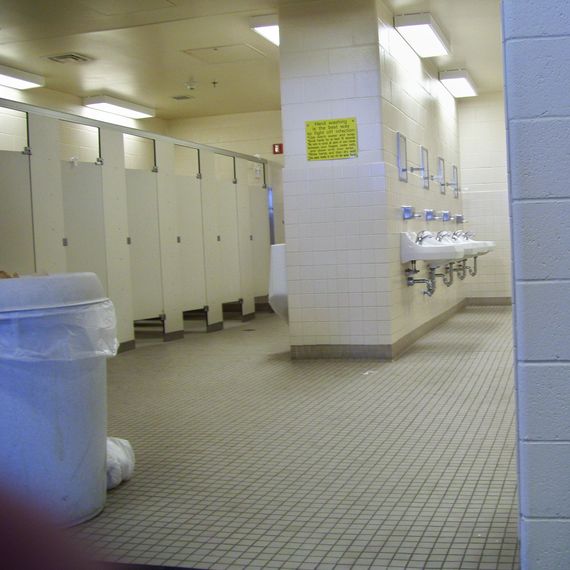
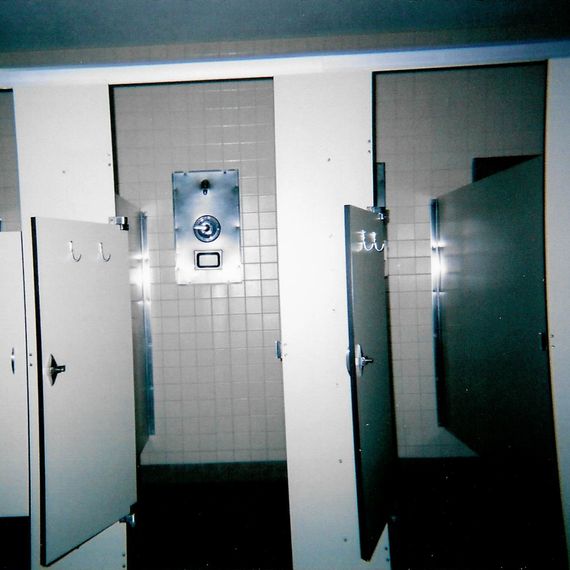
Bathroom and shower facilities at a minimum-security federal prison. All inmates are expected to shower daily. Courtesy of The MPM Group, Inc..
Bathroom and shower facilities at a minimum-security federal prison. All inmates are expected to shower daily. Courtesy of The MPM Group, Inc..
Weapons for the agents would pose another dilemma. The Bureau of Prisons does not allow people to carry firearms in its facilities — weapons are stored in on-site armories — but the Secret Service might insist on this for the agents protecting Trump. That in turn would introduce collateral risks, like the possibility that an inmate might be able to take a gun off an agent.
“There’s a whole new set of protocols that have to be developed just for” Trump, said Hurwitz, who added that staff on site would need to receive additional training and that there would be significant expenses associated with the effort. “The biggest ones probably will be in any security upgrades or communication upgrades that are going to be needed for that facility.”
In the end, all of this would be challenging and costly — but doable. “The men and women of the Secret Service are so mission oriented,” James told me, “that if that became the mission” — protecting Trump in prison — “there would be people who would, frankly, embrace it, and they’re going to make a lousy situation as good as they can. They’re going to make sure that the president is as safe as he can be.”
It is also possible that Trump would ultimately avoid the modest confines of a minimum-security facility and, like former French president Nicolas Sarkozy, serve out his time at home. “I have to believe there’s a way between the courts, the Secret Service, the Justice Department — they will find a way to have him serve in-home confinement,” Hurwitz said, because “it’s not in anybody’s best interest to have him in a prison.”
The Secret Service would likely be lobbying in favor of home confinement too, James said. “He just sits at Mar-a-Lago — maybe they take his passport, they order him not to travel, and he just has to just sit in Mar-a-Lago the whole time. Because we already have that facility secured, it would be a simple task for us.”
One wrinkle: Mar-a-Lago is both Trump’s home and a lavish private club — far nicer, of course, than the “Club Fed” stereotype associated with minimum-security prisons — which dramatically dilutes the punitive effect as well as Trump’s isolation. The property boasts more than a hundred rooms, a pool and spa, two ballrooms, a nine-hole “pitch and putt” golf course, five tennis courts, and more on the 20-acre property. According to an indictment prepared for some of Trump’s other alleged crimes, the club “hosted more than 150 social events, including weddings, movie premieres, and fundraisers that together drew tens of thousands of guests” between January 2021 and August 2022.
The standard methods of federal home confinement involve an ankle bracelet on the convict, which alerts a probation officer if he leaves a designated area. The traditional ankle bracelet model tends to be “challenging” when the defendants “have large residences,” Chris Maloney, the former chief U.S. probation officer in the district of New Jersey and the district of Massachusetts, told me.
Another option is a curfew system in which the defendant is required to be on-site during certain hours. Maybe they can go out during certain hours of the day but otherwise have to stay home in the evenings and on the weekends. “The officer uses other methods to monitor that — whether it’s a home visit or calling them on the phone,” Maloney explained. In Trump’s case in particular, an ankle bracelet might not be necessary given the fact that the Secret Service would be in close proximity and that it would be difficult for someone as recognizable as Trump to go anywhere without someone noticing.
The judge could restrict Trump’s movements to certain parts of Mar-a-Lago, but in the absence of some strict conditions, he could remain free to enjoy everything the property had to offer. “Nothing precludes somebody that’s on home confinement from doing those types of things unless the judge adds a condition on something like that,” Maloney told me. “If they’re within their home — let’s say you have a well-to-do defendant that has an 8,000-square-foot house and has lots of parties and lots of people over — there’s nothing wrong with that.”
This does not sound so bad on its face, I told Maloney, but he offered a countervailing view. “After a few months — especially for somebody who’s used to traveling on a whim and going wherever they want to go — it gets punitive pretty quick,” he said. Even Mar-a-Lago, he offered, could “start feeling like a prison after three months.”
Donald Trump’s Mar-a-Lago estate in Palm Beach, Florida.
Photo: Joe Raedle/Getty Images
A home-confinement model could include allowances for Trump to travel to some of his other properties — including his penthouse in Trump Tower in Manhattan and his golf club in Bedminster, New Jersey — with the approval of probation officers and the judge. Maloney said such allowances for felons with multiple homes are “not uncommon.”
Douglas Berman, a law professor and leading authority on federal sentencing law, sounded dovish when I asked him how he might advise Judge Chutkan. He told me he would encourage her to consider whether “the fact of a conviction alone, under these kinds of circumstances, is punishment enough” and whether putting Trump in prison for any period of time could do more harm than good.
“I somewhat fear Trump always ends up a winner in his own story, no matter what happens, so I’m not really worried about him,” Berman told me. “I am worried about the country.”
The prospect of Trump in some sort of modified political exile at Mar-a-Lago or a minimum-security prison is not likely to satisfy his most dogged critics, some of whom have recently taken to predicting that Trump will die in prison. But there would still be some measure of justice in seeing Trump in these loosely confined settings. He would be further stigmatized, and provided he loses to Biden in November, his legacy would be in tatters — a wildly unpopular one-term president, a political failure, a historically unprecedented criminal who tried to cling to power in shocking, anti-democratic fashion.
The other criminal cases against Trump may not significantly affect the contours of the result. A conviction in the classified-documents case being tried in Florida could result in additional time for Trump, but that could be designated by the sentencing judge to run concurrently with his other sentence, or it could simply be tacked on to whatever period of federal incarceration and/or home confinement he is already required to serve. Even assuming that Trump is convicted in the state cases, the state judges and prison officials would face even more difficult versions of the logistical and security problems that Chutkan and federal officials would confront; the most straightforward solution might simply be for the judges to impose sentences that would run while Trump is in federal custody, wherever that ultimately is.
This punishment would likely be much less dramatic, much less onerous than the supermax prison that many people have imagined for Trump, but it is also, in its own way, much more psychologically diminishing. The crudeness of the criminal-justice system has a way of flattening people, and at the end of the day, Trump may not warrant treatment as some sort of international criminal mastermind who could break free at any moment. He would be just another failed and frail elderly white-collar convict.

